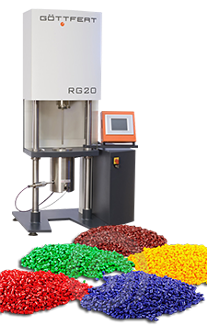Material Measurement
Many commonly-used materials and formulations exhibit complex rheological properties, whose viscosity and viscoelasticity can vary depending upon the external conditions applied, such as stress, strain, timescale and temperature. Polymers and rubber are combined with a variety of different additives in order to give them properties that are important for many different markets.
COMPUPLAST® VEL™ includes a basic material database of typical materials used in different extrusion processes. However, in order to get more precise results from a simulation, it is highly recommended to measure the material rheological properties of the actual polymer that is used in the process that is being simulated.
COMPUPLAST® offers to customers the proper material measurement so as preparing the material in Viscosity Fitting (VEL™ Material Properties module) for calculation.
The basic polymer property which needs to be measured is the Shear Viscosity. The shear viscosity is a measure of the resistance of the fluid against an applied shear force. Inside the equipment (flow between walls) the shear viscosity is the most important material characteristic.
Other material properties which can be measured and used for simulation include:
Elongational Viscosity
The elongational viscosity is a measure of the resistance of the fluid against an applied elongational force. Outside the equipment (i.e. during stretching), the elongational viscosity is the most important material characteritic. Elongational flow is a special type of flow that occurs when the material is accelerated (elongated or stretched). As such, the elongational viscosity can also effect the flow within a die if the material is forced to accelerate rapidly.
It has been found that the elongational viscosity is much more sensitive to the material structure than the shear viscosity and so, it is a more difficult characteristic for resin companies to control during the polymerization process. In general if you have a situation in which two materials have almost identical similar shear viscosity yet, one material (or lot) processes poorly and the other material (or lot) processes well, then it may be a good idea to study the elongational viscosity.

Wall Slip
An effect that is becoming more and more important is slip at the wall. One of fundamental assumptions in fluid mechanics is that liquids stick completely to walls, in other words that the velocity at the wall is zero. For polymer melts, that generate high stresses, it can happen that the material does not stick to the wall but it moves slowly (slips) along the wall. This effect is called Wall slip.
This effects is common for rigid PVC but it is also being observed in other polymers that exhibit high shear stress at the wall or with certain additives (i.e processing aids). Wall slip is another characteristics that may need to be measured and included in the simulation of the process.
Other measurement services we can provide:
- Conductivity of the material (for chosen pressures and thermal conditions)
- Melt Fracture
- Die Swelling
- PVT diagrams
- Cross-linking (using UV radiation)
Contact us with your measurement request
via email This email address is being protected from spambots. You need JavaScript enabled to view it. or call +420 577 220 451